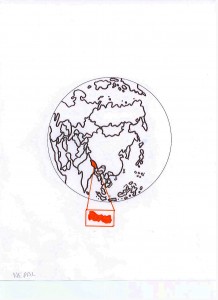NEPAL
A. THE COUNTRY
The Federal Democratic Republic of Nepal is a mountainous Himalayan
landlocked country in South Asia. It contains 8 of the 10 highest
mountain peaks in the world. In 2008, the government became a secular
multiparty constitutional republic. In the 1990’s and 2000’s, there
were many human rights abuses during the civil unrest. Not one person
has been prosecuted, and the Maoist leadership – now holding Nepal’s
reign of power – would suffer greatly were their evil deeds brought to
light. Addressing the issues of impoverished rural communities and
resisting perceived “foreign interference” currently dominates political
rhetoric. Subsistence agriculture occupies up to 90% of the population.
Poverty and unemployment keep the country from progressing.
Geographical isolation, difficult terrain, poor infrastructure, rapid
deforestation, environmental damage and susceptibility to natural
disasters all weigh against development. There is great potential for
hydroelectric power and tourism.
B. THE PEOPLE
The population is ~29,900,000 and official language Nepali. There are
~100 ethnic groups, consisting of over 30 peoples, sub-groups and
castes. Caste is often as important a distinction as ethnicity though
technically illegal. ~78% are South Asian, ~21.5% Tibetan-Himalayan,
~0.5% Other (other Asian and Western ethnicities).
Nepalis illegally working abroad may exceed 10 million.
Young people comprise two-thirds of the population and most live in
rural areas where illiteracy is widespread. They are vulnerable to
economic exploitation, sex trafficking, drug abuse, HIV/AIDS and
radicalization (political or religious).
C. RELIGIONS AND CHRISTIANITY/PENTECOSTALISM
Religious freedom is guaranteed by law, but only in limited measures.
Non-Hindus cannot proselytize but, despite this law, the Church in Nepal
grows. Hindu fundamentalism has increased in recent years. Persecution
of Christians remains though less than in the past. ~75.01% are Hindu,
~16% Buddhist, ~4.4% Muslim, ~2.85% claim to be Christian, ~0.9% Other,
~0.75% Non-religious, ~0.06% Sikh, ~0.03% Baha’i. The boundary between
Hinduism and Buddhism is often difficult to distinguish.
In the Christian category:
~2.41% are Independent, ~0.44% Protestant, ~0.02% Catholic, ~0.02% are
considered ‘marginal’.
Evangelicals represent ~2.8% of the population.
Charismatics represent ~2% and of those ~0.6% are Pentecostals.
Donna Siemens
References:
http://en.wikipedia.org
Operation World, Jason Mandryk. Colorado Springs: Biblica Publishing, 2010.

